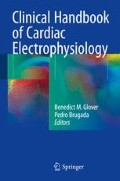Abstract
Ventricular pre-excitation occurs as a result of an extranodal accessory pathway connecting the atrium with the ventricle along the AV groove. Although the baseline ECG may be normal, the common features seen are a short PR interval during normal sinus rhythm, slurring of the initial portion of the QRS complex resulting in a delta wave, a QRS duration greater than 120 ms in adults, and secondary ST and T wave changes, all of which result from a combination of eccentric accessory pathway and midline AV nodal conduction. Ventricular pre-excitation in association with a history of palpitations is named the Wolff–Parkinson–White (WPW) syndrome.
Access this chapter
Tax calculation will be finalised at checkout
Purchases are for personal use only
References
Becker AE, Anderson RH, Durrer D, Wellens HJ. The anatomical substrates of Wolff-Parkinson-White syndrome: a clinicopathologic correlation in seven patients. Circulation. 1978;57:870.
Ho SY. Accessory atrioventricular pathways: getting to the origins. Circulation. 2008;25(117):1502–4.
Peters NS, Rowland E, Bennett JG, et al. The Wolff-Parkinson-White syndrome: the cellular substrate for conduction in the accessory atrioventricular pathway. Eur Heart J. 1994;15:981.
Fox DJ, Klein GJ, Skanes AC, et al. How to identify the location of an accessory pathway by the 12-lead ECG. Heart Rhythm. 2008;5:1763–6.
Haissaguerre M, Gaita F, Marcus FI, Clementy J. Radiofrequency catheter ablation of accessory pathways. a contemporary review. J Cardiovasc Electrophysiol. 1994;5:532–52.
PACES/HRS expert consensus statement on the management of the asymptomatic young patient with a Wolff-Parkinson-White (WPW, ventricular preexcitation)electrocardiographic pattern: developed in partnership between the Pediatric and Congenital Electrophysiology Society (PACES) and the Heart Rhythm Society (HRS). Endorsed by the governing bodies of PACES, HRS, the American College of Cardiology Foundation (ACCF), the American Heart Association (AHA), the American Academy of Pediatrics (AAP), and the Canadian Heart Rhythm Society (CHRS). Heart Rhythm. 2012;9:1006–24.
Epstein MR, Knapp LD, Martindill M, et al. Embolic complications associated with radiofrequency catheter ablation. Atakr Investigator Group. Am J Cardiol. 1996;77:655–8.
Otomo K, Gonzakez MD, Beckman KJ, et al. Reversing the direction of paced ventricular and atrial wavefronts reveals an oblique course in accessory AV pathways and improves localization for catheter ablation. Circulation. 2001;104:550.
Nakagawa H, Jackman WM. Catheter ablation of paroxysmal supraventricular tachycardia. Circulation. 2007;116:2465–78.
Jazayeri MR, Dhala A, Deshpande S, et al. Posteroseptal accessory pathways: an overview of anatomical characteristics, electrocardiographic patterns, electrophysiological features, and ablative therapy. J Interv Cardiol. 1995;8:89–101.
Sternick B. Automaticity in a Mahaim fiber. Heart Rhythm. 2005;2(4):453.
Calkins H, Yong P, Miller JM, et al. Catheter ablation of accessory pathways, atrioventricular nodal reentrant tachycardia, and the atrioventricular junction: final results of a prospective, multicenter clinical trial. The Atakr Multicenter Investigators Group. Circulation. 1999;19(99):262–70.
Sternick EB. Mahaim Fibre Tachycardia: Recognition and Management. IPEJ. 2003;3:47–59.
Bohora S, Dora S, Namboodiri N, et al. Electrophysiology study and radiofrequency catheter ablation of atriofascicular tracts with decremental properties (Mahaim fibre) at the tricuspid annulus. Europace. 2008;10:1428–33.
Author information
Authors and Affiliations
Corresponding author
Editor information
Editors and Affiliations
Rights and permissions
Copyright information
© 2016 Springer International Publishing Switzerland
About this chapter
Cite this chapter
Glover, B.M., Brugada, P. (2016). Accessory Pathway (AP) Conduction. In: Glover, B., Brugada, P. (eds) Clinical Handbook of Cardiac Electrophysiology. Springer, Cham. https://doi.org/10.1007/978-3-319-40818-7_5
Download citation
DOI: https://doi.org/10.1007/978-3-319-40818-7_5
Published:
Publisher Name: Springer, Cham
Print ISBN: 978-3-319-40816-3
Online ISBN: 978-3-319-40818-7
eBook Packages: MedicineMedicine (R0)

